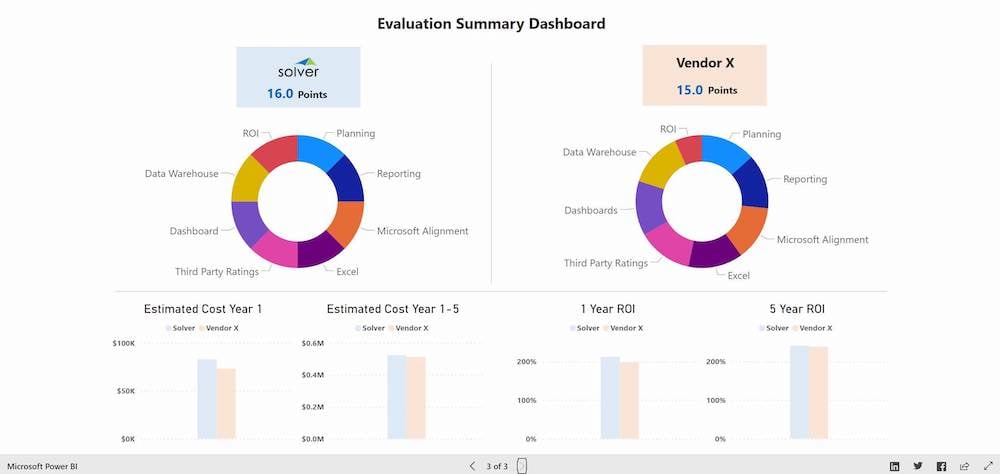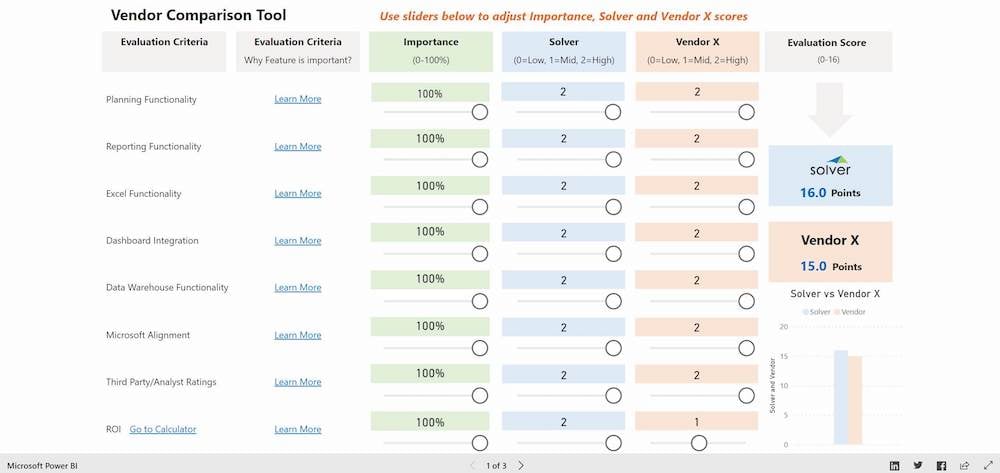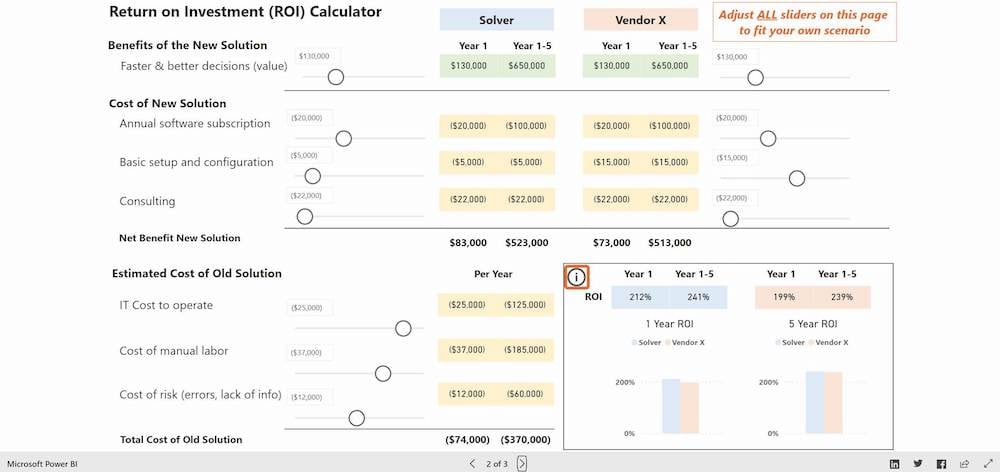Related Posts
How to Evaluate the Best Corporate Performance Management (CPM) Tools

In today’s fast-paced business landscape, it is a truism that agility is the key to success. It is also a truism that agility is powered by accurate, up-to-the-second, actionable data that drives quick and confident decision-making.
Since you are here reading this article, you already know that CPM tools (defined as Corporate Performance Management software including budgeting software and financial reporting software) deliver one of the best ways to ensure your enterprise has access to up-to-date, accurate data at all times.
But which are the best Corporate Performance Management tools that you should use for your organization? There are quite a few options for budgeting and reporting software out there – and it is important that your company choose the right one.
To help, here is the in-depth guide with the information you need for choosing Corporate Performance Management software.
PART 1 - Key Evaluation Criteria for CPM Tools

First, before you dive into specific details about how to evaluate CPM tools, you will want to determine the most important evaluation criteria for your specific corporation.
Later on in this article, you will gain access to an interactive CPM evaluation tool, which will help you clearly compare your CPM options. Using the tool will require you to prioritize your company’s needs. The following introductory section will help you establish a process that gets you on the path to determining your priorities.
When considering your options for budgeting and reporting software or CPM tools, it is a smart idea to:
Assess your business requirements
Do you have a specific ERP that you need to integrate with your Corporate Performance Management solution?
Will your executive team and/or employees need access to cloud-based reporting that they can access from their home office or mobile device on the go?
Does your company have a global footprint that includes a large number of subsidiaries in various countries requiring complex, multicurrency consolidations?
What type of industry are you in, and what does that mean for your business model (service based, product based, etc.)?
Does your executive team rely on real-time data to make agile decisions?
Are you, like many modern corporate leaders, replacing your annual budgeting process with forecasting?
These are just a few of the questions to consider before you start to evaluate various CPM tools. When coming up with additional questions to ask, think about how well your current reporting and budgeting software solutions support your team.
The next step should help you get critical details on your current solutions strengths and weaknesses.
Seek out department perspectives
Current best practices recommend using the best corporate performance management tools across the enterprise, which means every department from Finance to Sales to Marketing to Customer Support and beyond should have access to your company’s budgeting and reporting software solution(s).
Since each of your departments should already have been using reporting software or budgeting software in some capacity, each department will probably have strong opinions about what works (and does not work) about your current setup.
When you invite this critical departmental feedback and ensure that all your departments understand how to evaluate CPM tools, you will be much better prepared to select the one right Corporate Performance Management suite that drives productivity and performance across your entire company.
The next step should help get your departments thinking about the options they would have with new CPM tools.
Get a close look at the available CPM tools
One great way to get the executive team and each of your departments thinking about what works and does not work for their planning and reporting needs is to have all stakeholders at your company familiarize themselves with what is available in each potential CPM tool you are considering.
When evaluating all the best CPM software tools on the market, make sure to ask each vendor for a full tour of the product. A tour differs from a demo because it empowers the viewer (you) to self-direct your explorations of the product, at your speed. (Conversely, a demo is typically performed at top speed and usually focuses solely on exciting, “gee whiz” features, while downplaying or hiding product gaps or flaws.)
By accessing a fully interactive product tour, you and your team members will have control of the reins when investigating a CPM solution – instead of leaving all the control in the product salesperson’s hands.
Best of all, a self-directed, interactive product tour empowers you to return to your product explorations again and again as you learn more about each tool you are evaluating. This helps you gain a greater perspective on how you want to compare key features and functions.
Want to see how a tour works? Try out the Solver Suite tour here.
Focus on unbiased research
At this point, we all trust the internet to help us explore and compare the products we want for our personal lives and our businesses. However, you need to make sure that the reviews you read are as unbiased and comprehensive as possible, especially when it comes to purchasing a critical business performance solution like Corporate Performance Management software.
CPM or budgeting and reporting software solutions leverage up-to-date, accurate data to drive fast decision-making at your company. That means that it could be a big mistake to purchase software based on biased reviews that feature misleading or out-of-date information.
Trustworthy, unbiased third-party analysts like Dresner Advisory Services grow their earnings by regularly publishing updated research supported by survey-driven, fully comprehensive software analyses. Analysts like these are an incredible resource.
However: BEWARE WHICH “REVIEWERS” YOU TRUST. As you are looking for third-party analyst reviews, you will quickly find that it can be hard to sort out the most trustworthy and unbiased reviewers from the sham, “pay to play,” so-called reviewers that award vendors who are willing to pay to be named. (What a shady practice!)
Compare all prices, including hidden costs
How many times have software vendors told you that “the price of a product is not really important”?
How many times have you discreetly rolled your eyes at that statement?
Of course, cost is important!
No matter how many times salespeople try to convince you that the price of their solution is not an important consideration, you know that keeping to a reasonable budget is extremely important to long-term business success (and also important to your long-term job security). After all, if the budget is not truly important, then why do the vast majority of corporations spend months of time on crafting a budget every single year?
For a quarter of a century, the Solver team has been selling reporting and budgeting software / CPM tools to business leaders – and we have also been buying software for our own company. We know that price is a very important factor in making a purchasing decision.
Or, to be crystal clear, we know that assessing the true price of a solution is critical for making a smart purchasing decision.
What do we mean by “true price”? We mean the full cost, including hidden costs like running on-premises software on additional servers that require extra cooling and energy, as well as intangible costs, like the cost of frustration and anger that arise when using an unreliable or out-of-date reporting and budgeting software solution.
Using an in-depth ROI calculator like the Vendor Comparison & ROI Tool can help you track down the true cost of each CPM solution your enterprise is considering. This can help you ensure that you are viewing the most accurate and comprehensive costs at all times.
When you are looking into how to compare CPM tools, make sure to get the details on what you are spending now and get very granular costing information from each vendor. This data, when entered into the Vendor Comparison & ROI Tool, will help you determine your true cost for each CPM solution.
Not sure where to start? Get help from Solver. The budgeting and reporting software experts at Solver are happy to help you figure out how to evaluate the best corporate performance management tools available to your enterprise. We offer unbiased assessments of our software compared to our competitors, so you can be sure you are making the right choice for your business’s long-term needs.
PART 2 - How to Evaluate CPM Tools: Focus on These 8 Prioritization Areas

You know all businesses are entirely unique, but you may not realize that all business software solutions are entirely unique as well. This especially applies to reporting and budgeting software solutions, which are known to specifically support various business needs (such as consolidations) or various industries (such as project-based firms).
This is all to say that there is likely only one CPM tool that will fit your corporation like a glove – and now it is time for you to learn how to find that tool.
After determining your company’s evaluation criteria using the previous section, you will be better prepared to clearly understand which of the following areas are most important to your needs.
1. Planning Functionality
Planning software delivers the ability to create accurate budgets and updated forecasts. These functions are critical when planning for resource allocations and they help you maintain agility in times of economic uncertainty.
As you know, creating a plan is only the first step to successful plan execution. Arguably the more important capability is that of identifying after the budget is created, where and how the budget can and should be adjusted to meet shifting situations. Planning software focuses on budgeting and forecasting functionality, making it easier to run your enterprise no matter what the future brings.
Some of the key functions in good planning software (also known as budgeting, planning and forecasting software) are:
- Easy-to-use template designers
- Line item detail and commenting capabilities
- Workflows and checklists that keep planning tasks on track
- ERP and payroll integrations
- Cloud capabilities that support modern business expectations
If you are ready to learn more about how to evaluate CPM tools, it is a smart idea to read the in-depth article about top planning features to look for during your CPM selection process.
2. Reporting Functionality
Reporting and analysis software is the key to success when running a business. Accurate, up-to-the-minute reports empower corporate leaders to maintain a close watch on the progress of key strategic initiatives and help maintain maximum confidence during rapid-fire decision-making.
All businesses need to collect data – most are already doing so. However, collecting the data provides little value if you are unable to analyze that data with easy-to-understand reports.
Important features that help your team create and use reports include:
- Advanced report formatting
- Advanced formulas
- The ability to report on data from other sources than the ERP
- Excel add-in integration
- True consolidation features
- Close process checklists and workflows
- ERP integrations
- Cloud architecture
To improve reporting capabilities at your company, you will want the most details at your disposal. Therefore, you will want to read this more in-depth look at reporting features available in CPMs on the market today.
3. Excel Functionality
Remember back between 2010-2015 when all the reporting software vendors said everyone would be getting rid of Excel soon? That did not happen. Instead, Excel became even more important as business data became more complex.
Almost all successful enterprises in the modern world use Excel to some extent, which means that making your Excel usage faster and easier for your company can save hundreds of hours of labor time over the course of each year.
Excel features that can streamline your operations, improve data management and increase productivity include:
- Excel add-ins
- Web portals with Excel add-ins
- Dynamic Excel rows, columns, and global parameters
- Excel as the primary (or better yet, the only) design tool
- Cloud data integration
Read the in-depth article on Excel functionality so you can find out more about how Excel features in your CPM tool can help your entire team get more done, faster.
4. Dashboard Integration
In the modern world, most people prefer to receive information in graphical form because, as they say, a picture is worth a thousand words (or a thousand spreadsheet cells, in this case). Dashboards deliver your corporation’s most crucial data in easily digestible, graphical images.
However, to get the most from your dashboards, you need to ensure they provide full integration between your CPM tools, your ERP, your CRM, and any other data collection sources your business may use.
In general, there are 3 ways you can get dashboards to integrate with your Corporate Performance Management solution:
- Static, embedded charts in financial reports
- Proprietary dashboards in your CPM portal (sometimes a limited selection)
- Integrated, best-in-class dashboards like Power BI
Get the facts on the benefits and drawbacks for these 3 options when you check out the article on dashboard integration within your CPM solution.
5. Data Warehouse Functionality
A data warehouse safely stores a wide range of business data from various sources. The benefit to a data warehouse, as compared to older OLAP cube technology or other prior solutions, is that data stored in a warehouse can be easily and quickly accessed on demand. In addition, the data can be combined in creative ways that provide deeper insight, as well as “sliced and diced” to get detailed information.
Here’s what you need to know about data warehouses to ensure you get the most cost-effective and efficient solution for your enterprise:
- Key differences between the leading data warehouse platforms
- The costs of setting up a homegrown data warehouse versus a commercial solution
- Whether or not to combine your data warehouse with your CPM solution
- Various ways to integrate data into your data warehouse
- Common (and not so common) management capabilities available with data warehouses
Gain a clear overview into each of these considerations when you access the updated article about selecting the right data warehouse for your needs.
6. Microsoft Alignment
Larger corporations typically rely on many Microsoft solutions to keep their businesses running. It is likely that nearly everyone at your enterprise uses Microsoft software, cloud platforms and services, and collaboration tools on a daily basis. When everyone relies so much on such a small handful of tech tools to maintain operations, it can become a true setback to manually re-build integrations to each critical Microsoft tool.
Microsoft alignment with your CPM is essential to keep your company running smoothly, so if you are wondering how to evaluate CPM tools, you should certainly look for integration with:
- Office 365 / Microsoft 365
- Power BI
- Teams
- Dynamics ERP solutions (both cloud and legacy)
- Azure (this matters if your company is already leveraging Azure for other processes)
Sometimes, Microsoft integrations come with an extra cost from your CPM vendor. You can learn more details like this when you read the in-depth Microsoft alignment article from Solver.
7. Third-Party Analyst Ratings
When you are trying to figure out how to evaluate CPM tools, one of the best resources you can turn to is a third-party analyst like Dresner Advisory Services or Gartner. As we discussed earlier in Part 1 of this guide, it matters who you choose to provide your unbiased research.
If you choose to perform research using a third-party analyst, or if you are considering whether to hire a research firm as a consultant to help you select the right CPM tool for your needs, make sure to consider:
- Whether it is truly important to use a third-party analyst for your research
- Who the leading analysts are
- How to tell whether an analyst you are considering is biased or fair
- The gap of time between research data collection and report publication
Discover if your company should rely on a research firm (or not) when you read up on the details in the article on using analyst rankings to select a CPM solution.
8. Return on Investment (ROI)
The bottom line of any business transaction is to ensure a profitable Return on Investment (ROI). Unfortunately, many businesses do not know how to evaluate their ROI, nor how to calculate it.
Having the right ROI tools at your disposal is critical to accurately assessing the true costs and benefits of your Corporate Performance Management solution investment (get a free ROI calculator here). It is also critical to understand why ROI must be calculated and how your company can best leverage your ROI calculation results.
The top 3 questions you need answered are:
- Why should you always calculate ROI before making a CPM tool purchase decision?
- How can you best calculate a comprehensive ROI?
- What are the additional details to consider when performing your calculations?
To get the answers to these questions and more, read the detailed blog exploring and explaining the importance of ROI calculations.

PART 3 - Discover Which CPM Tools Are Available to You
While in the process of deciding on a CPM software tool, you have probably noticed that there are many options available to you (especially when you add in a search for top EPM solutions, which stands for Enterprise Performance Management and is the older term for CPM).
Some of the most well-known names in the CPM / EPM industry include:
- Adaptive
- Prophix
- Solver
- Planful
- Vena
- Jet Reports
- Anaplan
- DeFacto
Each of these solutions has their own unique features, ERP integrations, cloud architecture options, and industry focus areas – not to mention their own “flavors” of functionality for the 8 prioritization areas we mentioned earlier.
Make It Easier to Compare Your Options for CPM Tools: Use the Vendor Comparison & ROI Tool
When you are first diving in and learning how to evaluate CPM tools or budgeting/reporting software, it can seem like an overwhelming task to determine which one of the many, extremely different Corporate Performance Management solutions is right for your enterprise.
Solver is here to make your job easier.
To help you sort through your options, the CPM experts at Solver have created a fully interactive dashboard tool, the Vendor Comparison & ROI Tool, which you can use to objectively compare any CPM solutions. You can even use the tool to assess your current budgeting and reporting software solution, so you can compare its strengths and weaknesses to other CPM solutions you are interested in.
As you will see when you access the Vendor Comparison & ROI Tool, the tool provides you with 3 dashboard screens:
- Screen 1 helps you select the priority of each of the 8 prioritization areas
- Screen 2 is an ROI tool that helps you clearly identify all CPM costs, including hidden costs you may not have thought about
- Screen 3 delivers an objective score and summary for the CPM tool you are evaluating, taking your unique prioritizations and ROI into account
That’s it. No tricks, no purchase necessary, no obligation to sign up for a free trial… no drawbacks whatsoever.
Why are we offering this in-depth tool completely free? Simple. Here at Solver, we are numbers people. We think that seeing objective comparative data is the best way to make confident, fast, smart decisions that positively impact your business.
In fact, that is our mission here at Solver: to help our customers make faster, smarter decisions.
That underlying mission applies to everything we do, all the time – even when it comes to helping you figure out how to evaluate CPM tools for your company.
Start your search for your enterprise’s perfect CPM tool today.
Get the Vendor Comparison & ROI Tool now.
Solver gives you access to hundreds of financial planning templates and reports, plus our extensive template glossary and experienced staff who are always happy to share their expertise. Solver is committed to helping you with all your planning and reporting needs, so you can proceed confidently into your business’s financial future.
Global Headquarters
Solver, Inc.
Phone: +1 (310) 691-5300
